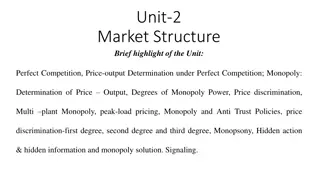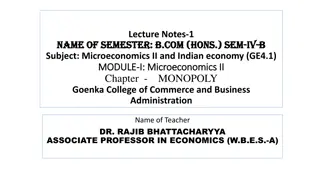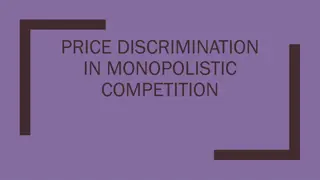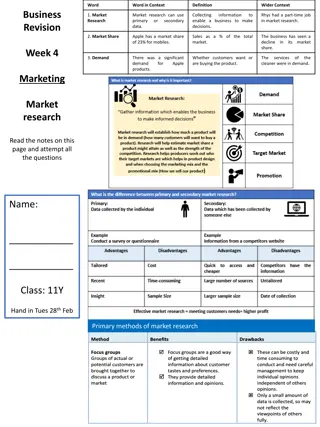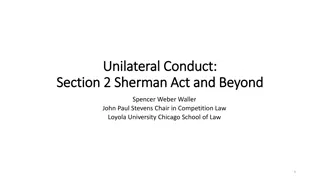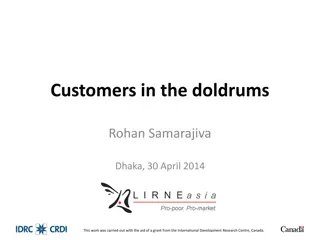Introduction to Monopoly Market Structure
Monopoly is a market condition where a single firm dominates the entire market due to barriers to entry such as legal, sociological, and natural barriers. This article explores the key differences between a monopolist and a perfect competitor, the reasons for monopolies, and how monopolistic firms maximize profit in the market.
Uploaded on Apr 09, 2025 | 0 Views
Download Presentation

Please find below an Image/Link to download the presentation.
The content on the website is provided AS IS for your information and personal use only. It may not be sold, licensed, or shared on other websites without obtaining consent from the author.If you encounter any issues during the download, it is possible that the publisher has removed the file from their server.
You are allowed to download the files provided on this website for personal or commercial use, subject to the condition that they are used lawfully. All files are the property of their respective owners.
The content on the website is provided AS IS for your information and personal use only. It may not be sold, licensed, or shared on other websites without obtaining consent from the author.
E N D
Presentation Transcript
Monopoly Mrs Sarika Singh FMS MLSU Udaipur
Introduction Monopoly market condition is opposite of perfect competition. Monopoly is a market structure in which a single firm makes up the entire market.
Introduction Monopolies exist because of barriers to entry into a market that prevent competition. Barriers to entry include legal barriers, sociological barriers, and natural barriers.
Introduction Legal barriers, such as patents, prevent others from entering the market until the patent expires. Sociological barriers not everyone has the brains to win a Nobel Prize nor the skill to slam-dunk a basketball. Natural barriers where the firm has economies of scale to produce what others cannot duplicate.
The Key Difference Between a Monopolist and a Perfect Competitor For a competitive firm, marginal revenue equals price: P = MR For a monopolist it does not. The monopolist must take into account the fact that its production decision will simultaneously set price.
The Key Difference Between a Monopolist and a Perfect Competitor A competitive firm is too small to affect the price. Monopolist does not take into account the effect of its output decision on the price it receives.
The Key Difference Between a Monopolist and a Perfect Competitor A competitive firm's marginal revenue is the market price. A monopolistic firm s marginal revenue is not its price it takes into account that its output decision can affect price.
A Model of Monopoly How much should the monopolistic firm choose to produce if it wants to maximize profit?
The Monopolists Price and Output Numerically The first thing to remember is that marginal revenue is the change in total revenue that occurs as a firm changes its output. The point is not to maximize total revenue but to maximize total profit.
The Monopolists Price and Output Numerically As in perfect competition, profit for the monopolist is maximized at a point where MC = MR. What is different for a monopolist marginal revenue does not equal price; marginal revenue is below price.
The Monopolists Price and Output Numerically If a monopolist deviates from the output level at which marginal cost equals marginal revenue, profits will fall.
Profit Maximization for a Monopolist Output 0 1 2 3 4 5 6 7 8 9 Price 36 33 30 27 24 21 18 15 12 9 TR 0 33 60 81 96 105 108 105 96 81 MR 33 27 21 15 9 3 3 9 15 TC 47 48 50 54 62 78 102 142 196 278 MC 1 2 4 8 16 24 40 56 80 ATC Profit 47 15 10 27 34 27 6 37 48.00 25.00 18.00 15.50 15.60 17.00 20.29 24.75 102 30.89 197
The Monopolists Price and Output Graphically The marginal revenue curve is a graphical measure of the change in revenue that occurs in response to a change in price. It tells us the additional revenue the firm will get by expanding output.
The Monopolists Price and Output Graphically To determine the profit-maximizing price (where MC = MR), one first finds that output and then extends a vertical line up to the demand curve.
The Monopolists Price and Output Graphically If MR > MC, the monopolist gains profit by increasing output. If MR < MC, the monopolist gains profit by decreasing output. If MC = MR, the monopolist is maximizing profit.
The Monopolists Price and Output Graphically The MR = MC condition determines the quantity a monopolist produces. That quantity determines the price the monopolist will charge.
The Monopolists Price and Output Graphically MC Price Monopolist price $36 30 24 18 12 6 0 6 D 1 2 3 4 5 6 7 8 MR 9 10 12
Comparing Monopoly and Perfect Competition Equilibrium output for the monopolist, like equilibrium output for the competitor in a perfectly competitive market is MC = MR.
Comparing Monopoly and Perfect Competition Because the monopolist s marginal revenue is below its price, its equilibrium output is less than, and price is higher than, for a competitive market.
Comparing Monopoly and Perfect Competition MC Price Monopolist price $36 30 24 18 12 Competitive price 6 0 6 D 1 2 3 4 5 6 7 8 MR 9 10 12
Profits and Monopoly To find a monopolist's profit it is important to follow the proper sequence.
The Proper Sequence to Find a Monopolists Profit Draw the firm's marginal revenue curve. Determine the output the monopolist will produce by the intersection of the MC and MR curves.
The Proper Sequence to Find a Monopolists Profit Determine the price the monopolist will charge for that output. Determine the average cost at that level of output.
The Proper Sequence to Find a Monopolists Profit Determine the monopolist's profit (loss) by subtracting average total cost from average revenue (P) at that level of output and multiply by the chosen output.
A Monopolist Making a Profit A monopolist can make a profit.
A Monopolist Making a Profit MC Price ATC A PM Profit B CM D MR 0 QM Quantity
A Monopolist Breaking Even A monopolist can break even.
A Monopolist Breaking Even MC Price ATC PM D MR 0 QM Quantity
A Monopolist Making a Loss A monopolist can make a loss.
A Monopolist Making a Loss MC Price ATC B CM Loss A PM D MR 0 QM Quantity
The Price-Discriminating Monopolist Price discrimination is the ability to charge different prices to different customers.
The Price-Discriminating Monopolist In order to price discriminate, a monopolist must be able to: Identify groups of customers who have different elasticities of demand; Separate them in some way; and Limit their ability to resell its product between groups.
The Price-Discriminating Monopolist A price-discriminating monopolist can increase both output and profit. It can charge customers with more inelastic demands a higher price. It can charge customers with more elastic demands a lower price.
Price Discrimination Occurs in the Real World Movie theaters give senior citizens and child discounts. All airline Super Saver fares include Saturday night stopovers. Automobiles are seldom sold at their sticker price. Theaters have midweek special rates.
Price Discrimination Occurs in the Real World Retail tire stores run special sales about half the time. Restaurants generally make most of their profit on alcoholic drinks and just break even on food. College-town stores often give students discounts.
The Price-Discriminating Monopolist Thus, it will produce the same quantity as will a perfectly competitive firm. For perfectly price-discriminating monopolist, P = AR = MR.
The Welfare Loss from Monopoly Why does the economic model see monopoly as bad? There is no necessary reason why a monopolist must make a profit. If the monopolist is a price discriminator, then its output is closer to the competitive output.
The Welfare Loss from Monopoly If profits are not the primary reason that economists see the monopoly model as bad, what standard should be used?
The Welfare Loss from Monopoly Compare the normal monopolist's equilibrium to the equilibrium of a perfect competitor. Equilibrium in both market structures is determined by the MC = MR condition.
The Welfare Loss from Monopoly But the monopolist's MR is below its price, thus its equilibrium output is different from a competitive market. The welfare loss of a monopolist is represented by the triangles B and D.
The Welfare Loss from Monopoly Price MC PM C D B PC A MR QC D 0 QM Quantity



